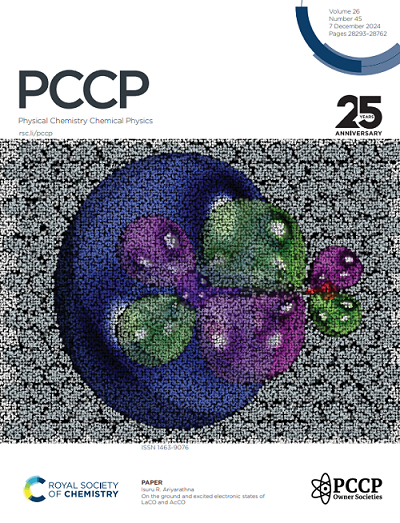具有ZrTe5势垒的vdW CrSBr自旋阀的邻近诱导自旋滤波
IF 2.9
3区 化学
Q3 CHEMISTRY, PHYSICAL
引用次数: 0
摘要
二维(2D)材料因其特殊的物理特性和在纳米电子学、自旋电子学和光电子学中的潜在应用而引起了人们的极大兴趣。范德华(vdW)异质结构的出现通过实现互补二维层的集成,进一步扩展了这一领域,从而产生了新的功能,如可调谐的带对齐,改进的自旋转移,以及磁性和超导性等邻近诱导效应,使其成为先进电子设备的理想选择。铁磁半导体与半金属的结合为探索自旋极化电流和提高自旋注入效率提供了新的可能性。在这项研究中,我们研究了半金属ZrTe5和铁磁半导体CrSBr的二维界面,重点研究了它们的结构、电子和磁性能。结果表明,自旋上载流子占主导地位,在费米能级上的自旋极化约为75.08%。由于邻近效应,CrSBr与单层ZrTe5的耦合显著提高了体系的磁矩。我们进一步研究了CrSBr/nL - ZrTe5/CrSBr自旋阀异质结构,系统地在平行(P)和反平行(AP)自旋对准下将ZrTe5层厚度从5层减少到单层。在ZrTe5中,P组态的磁矩随厚度的减小而增大,而AP组态的总磁矩抵消。输运计算表明,在零偏压下,单层ZrTe5结构的磁电阻(MR)比为495.75%。在偏置电压下,ZrTe5界面将P和AP配置下的自旋注入效率提高到90%以上,实现了自旋极化电流的精确控制和高效的自旋滤波。尽管将ZrTe5层从5层减少到1层,但这种性能在宽电压范围内仍然保持稳定,证明了异质结构的结构稳定性和适应性。这些发现奠定了CrSBr/ZrTe5/CrSBr系统作为高效自旋滤波和磁存储器件的可靠和可扩展平台,将其定位为下一代自旋电子技术的有前途的候选者。本文章由计算机程序翻译,如有差异,请以英文原文为准。
Proximity-Induced Spin Filtering in vdW CrSBr Spin Valves with ZrTe5 Barriers
Two-dimensional (2D) materials have attracted significant interest for their exceptional physical properties and potential applications in nanoelectronics, spintronics, and optoelectronics. The emergence of van der Waals (vdW) heterostructures has further expanded this field by enabling the integration of complementary 2D layers, resulting in novel functionalities such as tunable band alignment, improved spin transfer, and proximity-induced effects like magnetism and superconductivity, making them ideal for advanced electronic devices. The combination of ferromagnetic semiconductors and semimetals offers new possibilities for exploring spin-polarized currents and improving spin injection efficiency. In this study, we investigate the 2D interface of the semimetal ZrTe5 and the ferromagnetic semiconductor CrSBr, focusing on their structural, electronic, and magnetic properties using first-principles calculations. Our results show that spin-up carriers dominate, with a spin polarization of approximately 75.08% at the Fermi level. The coupling of CrSBr with a monolayer of ZrTe5 significantly enhances the magnetic moment of the system due to proximity effects. We further investigate the CrSBr/nL - ZrTe5/CrSBr spin-valve heterostructure by systematically reducing the ZrTe5 layer thickness from five layers to a monolayer under parallel (P) and antiparallel (AP) spin alignments. The P configuration exhibits an increased magnetic moment in ZrTe5 with decreasing thickness, while the AP configuration results in the cancellation of the total magnetic moment. Transport calculations reveal a magnetoresistance (MR) ratio of 495.75% at zero bias for the single-layer ZrTe5 structure. The ZrTe5 interface enhances spin injection efficiency to over 90% in both P and AP configurations under bias voltage, enabling precise control of spin-polarized currents and highly effective spin filtering. This performance remains robust across a wide voltage range, despite the reduction of ZrTe5 layers from five to one, demonstrating the heterostructure’s structural stability and adaptability. These findings establish the CrSBr/ZrTe5/CrSBr system as a reliable and scalable platform for high-efficiency spin filtering and magnetic memory devices, positioning it as a promising candidate for next-generation spintronic technologies.
求助全文
通过发布文献求助,成功后即可免费获取论文全文。
去求助
来源期刊

Physical Chemistry Chemical Physics
化学-物理:原子、分子和化学物理
CiteScore
5.50
自引率
9.10%
发文量
2675
审稿时长
2.0 months
期刊介绍:
Physical Chemistry Chemical Physics (PCCP) is an international journal co-owned by 19 physical chemistry and physics societies from around the world. This journal publishes original, cutting-edge research in physical chemistry, chemical physics and biophysical chemistry. To be suitable for publication in PCCP, articles must include significant innovation and/or insight into physical chemistry; this is the most important criterion that reviewers and Editors will judge against when evaluating submissions.
The journal has a broad scope and welcomes contributions spanning experiment, theory, computation and data science. Topical coverage includes spectroscopy, dynamics, kinetics, statistical mechanics, thermodynamics, electrochemistry, catalysis, surface science, quantum mechanics, quantum computing and machine learning. Interdisciplinary research areas such as polymers and soft matter, materials, nanoscience, energy, surfaces/interfaces, and biophysical chemistry are welcomed if they demonstrate significant innovation and/or insight into physical chemistry. Joined experimental/theoretical studies are particularly appreciated when complementary and based on up-to-date approaches.
 求助内容:
求助内容: 应助结果提醒方式:
应助结果提醒方式:


